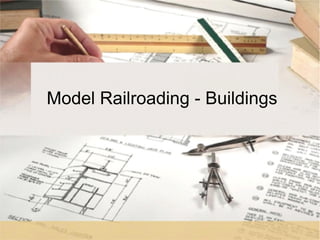Model railroading- buildings
- 1. Model Railroading - Buildings
- 2. A model train display's scenery is greatly enhanced by realistic buildings. Whether the theme is New York City or a small village, the model railroad buildings you use will illustrate all that is human about any landscape. If you are modeling a prototype scene, then you most likely will want to find or to make specific buildings for your display. If you are "freelancing," or making up, your cities and towns, then you can choose whatever buildings you want.
- 3. Hobby shops provide pre-made and ready-to- assemble kits for all kinds of model railroad buildings. Buildings from kits are typically made out of plastic and can be decorated with paint or decals. Some examples of buildings include:
- 4. Apartment complexes Large industrial plants Skyscrapers Movie theaters Row houses Barns
- 5. Stores Restaurants Gas stations Churches Railroad yards Buildings "under construction"
- 6. You may also choose to create your own buildings by altering a kit, combining kits or even building your own structures completely from scratch. You can use raw materials that you may already have at home, such as wood, foam, cardboard or paper. Then use an acrylic paint to decorate them accordingly. Creating original pieces may be necessary in cases when you are building a specific prototype and cannot find an exact kit.
- 7. In addition to the model railway buildings themselves, you can integrate accessories that enhance your display's realism. Accessories are basically anything that you would see in real life: people, cars, roads, trees, billboards, benches, chairs and fences. Strategically place items around your buildings to bring your display to life, such as:
- 8. Constructing driveways up to houses and planting trees around the yards Parking cars in business and industrial parking lots Placing people ice skating on a frozen pond Corralling animals in fences Lining up people waiting for the train at the railroad station Adding humor with a police car pulling over a speeding motorist
- 9. To further enhance the realism of buildings, you may consider pasting miniature pictures and curtains on the inside. Wiring small amber/yellow lights inside of buildings will also create a realistic nighttime effect and will "show" that people live and work in your buildings - just like in real life. Furthermore, applying a flat water-based acrylic weathering medium creates faux dirt and grime that are inherent to the outside of buildings, thereby enhancing your display's credibility. You can purchase this medium in different colors, such as brown/orange to mimic rust or black to represent soot or dust.
- 10. When placing model railroad buildings throughout a landscape, perspective also comes into play. Depending on how the display is set up, you may need larger buildings closer to the foreground and smaller buildings in the background. Small buildings "way off in the distance" can be made from painted wooden blocks - which not only saves money but it may also save time, as these may not need as many details as buildings closer to the foreground. Resources: http://www.youtube.com/watch?v=KKUhHcnBkYY http://ezinearticles.com/?Model-Railroading--- Buildings&id=5547565
- 11. Thank you for reading!











